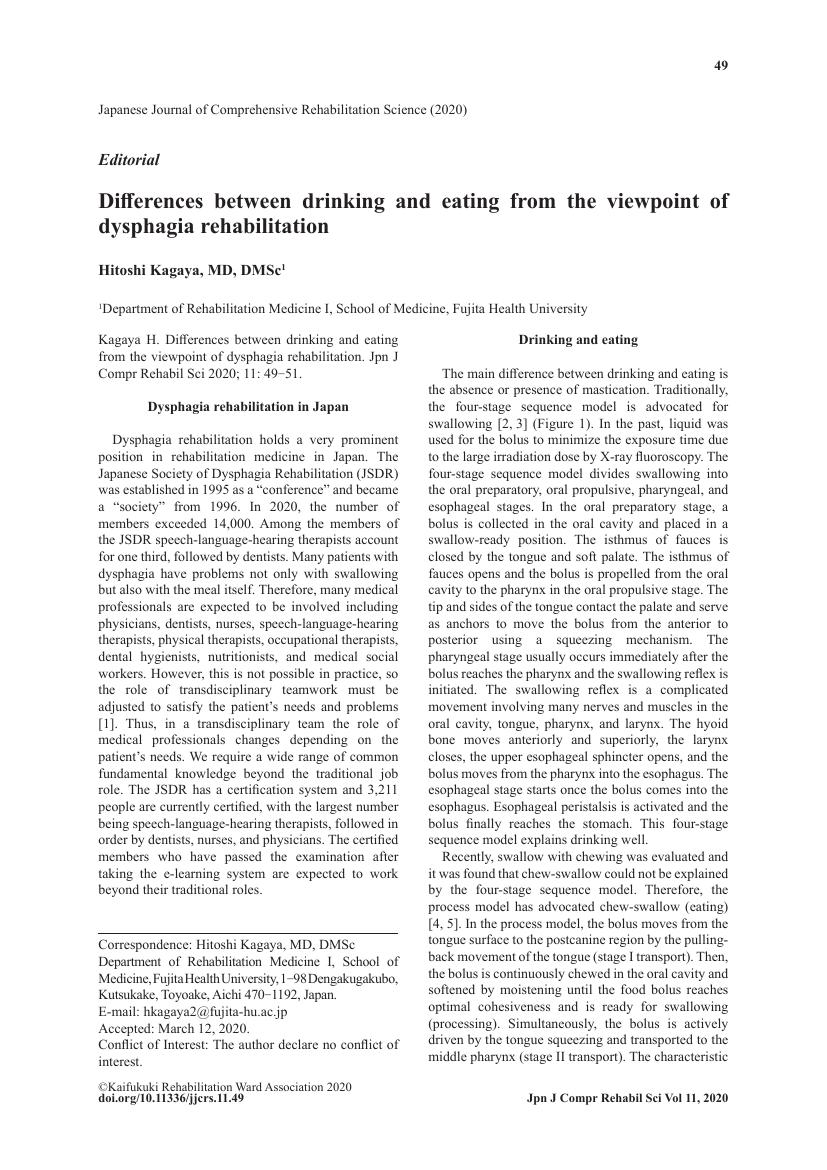- 著者
- Hitoshi Kagaya
- 出版者
- Kaifukuki Rehabilitation Ward Association
- 雑誌
- Japanese Journal of Comprehensive Rehabilitation Science (ISSN:21855323)
- 巻号頁・発行日
- vol.11, pp.49-51, 2020 (Released:2020-06-13)
- 参考文献数
- 12
- 被引用文献数
- 2 3
- 著者
- Fumihiro Matsuda Masahiko Mukaino Kei Ohtsuka Hiroki Tanikawa Kazuhiro Tsuchiyama Toshio Teranishi Yoshikiyo Kanada Hitoshi Kagaya Eiichi Saitoh
- 出版者
- Kaifukuki Rehabilitation Ward Association
- 雑誌
- Japanese Journal of Comprehensive Rehabilitation Science (ISSN:21855323)
- 巻号頁・発行日
- vol.7, pp.111-118, 2016 (Released:2016-12-30)
- 参考文献数
- 20
- 被引用文献数
- 19
Matsuda F, Mukaino M, Ohtsuka K, Tanikawa H, Tsuchiyama K, Teranishi T, Kanada Y, Kagaya H, Saitoh E. Analysis of strategies used by hemiplegic stroke patients to achieve toe clearance. Jpn J Compr Rehabil Sci 2016; 7: 111-118.Objective: The purpose of this study was to analyze the extent to which lower limb shortening and compensatory movements contribute to toe clearance during swing, and to identify the different strategies employed by healthy individuals and hemiplegic stroke patients to achieve toe clearance.Methods: The subjects comprised 18 hemiplegic stroke patients and 18 healthy individuals matched for age, gender, and walking speed. We calculated toe clearance and its components for comparison between the two groups. We also calculated the correlations between the components.Results: The foot-to-floor distance during mid-swing was smaller in hemiplegic stroke patients than in healthy individuals. Regarding the components, shortening of hip-toe length (SHTL) was smaller in stroke patients, whereas upward movement of the hip due to pelvic obliquity, upward movement of the foot due to abduction, and upward movement of the contralateral hip were all greater. Among hemiplegic stroke patients, there were significant negative correlations between SHTL and the other components.Conclusions: Hemiplegic stroke patients achieved smaller upward movement by lower limb shortening compared with healthy individuals. The contribution of hip hiking and other compensatory movements that correlated to SHTL appeared to be important in achieving toe clearance.
- 著者
- Megumi Ozeki Hitoshi Kagaya Yoko Inamoto Tomoko Iizumi Seiko Shibata Keiko Onogi Eiichi Saitoh
- 出版者
- Fujita Medical Society
- 雑誌
- Fujita Medical Journal (ISSN:21897247)
- 巻号頁・発行日
- pp.2019-018, (Released:2020-03-25)
- 参考文献数
- 15
Objective: The “chin-down” posture involves tucking the chin to the neck. However, clinicians and researchers have their own forms of the chin-down posture: some consider it to be head and neck flexion, whereas others consider it to be head flexion alone. The purpose of this study was to evaluate the effects of head, neck and combined head-and-neck flexion postures separately.Methods: Ten healthy volunteers participated in the study. The head and neck were set in neutral (N), head flexion (HF), neck flexion (NF) or combined head-and-neck flexion (HFNF) positions. Participants were instructed to swallow 4 ml of thick barium liquid in an upright sitting position. Head and neck angles at rest, distances in the pharynx and larynx at rest, and duration of swallowing were measured. Statistical analysis was performed with a paired t-test with Bonferroni correction.Results: Head angles in HF, NF and HFNF positions were significantly greater than in the N position. Neck angles were significantly greater in the NF position than in the N position. The distance between the tongue base and the posterior pharyngeal wall, the vallecular space and the airway entrance were smaller in the HF position than in the N position. The tongue base was in contact with the posterior pharyngeal wall longer in the HF position than in the N position.Conclusion: Because HF, NF and HFNF positions have different effects, we recommend the use of these terms instead of “chin-down position.”
- 著者
- Hidetaka Tsuzuki Yoko Inamoto Eiichi Saitoh Keiko Aihara Seiko Shibata Hitoshi Kagaya Keiko Onogi Enri Nakayama Mitsuyasu Sato Koichiro Ueda
- 出版者
- Nihon University School of Dentistry
- 雑誌
- Journal of Oral Science (ISSN:13434934)
- 巻号頁・発行日
- vol.62, no.1, pp.18-22, 2020 (Released:2020-01-29)
- 参考文献数
- 19
- 被引用文献数
- 7
This study used 320-row area detector computed tomography (320-ADCT) to determine whether kinematic swallowing events and bolus movement through the oropharynx are affected by bolus consistency and angle of recline. Fourteen healthy adults (4 men, 10 women; age, 22-90 years) underwent 320-ADCT assessment during three 10-mL barium swallow tests, with honey-thick liquid at 60° recline (60°thick), thin liquid at 60° recline (60°thin), and thin liquid at 45° recline (45°thin). The times of swallowing events were measured and compared among the different tests. Bolus propulsion, onset time of true vocal cord (TVC) closure, and upper esophageal sphincter opening were significantly earlier for 60°thin than for 60°thick. Onset time did not significantly differ between 60°thin and 45°thin; however, greater variability was noted for onset of TVC closure with 45°thin, as the TVC started to close before onset of swallowing in 30% of participants. Modulation of TVC closure depends on bolus transport in different reclining positions. The 45° reclining position elicited pre-swallow TVC closure in some participants, which suggests that excessive recline can increase perceived risk of airway invasion during swallowing.
